Yves here. The big news story this morning is that Russia has resumed serious pounding of Ukraine’s electric grid. As John Helmer explained in his initial post on that topic and continues today, Russia has been targeting transmission, not generation, and in particular, power lines going to areas Ukraine is contesting, as well as the train system in the east of the country. Note Ukraine’s rail system relies mainly on electric trains; diesel engines can also run on those tracks, but only a small minority of Ukraine’s train engines are diesel. And because the railroad gauge in Ukraine is different from that in Europe, the West can’t give Ukraine diesel engine substitutes. And of course, using the few diesel engines more intensively at the margin drains scarce diesel stocks faster.
Helmer mentions that Rybar is a key outlet for monitoring these attacks. The morning updates from Rybar via machine translation (emphasis original):
This morning, the RF Armed Forces launched massive strikes on substations that transmit electricity from hydroelectric power plants to the power grid. The intermediate goal is to deprive the enemy of the opportunity to compensate for the energy deficit.
One of the strikes was carried out on an open switchgear (ORU) of the Kaniv hydroelectric power station in the Cherkasy region .
The hydroelectric power station is located on the middle reaches of the Dnieper, helps to compensate for the energy shortage in the Kiev region , and at the same time has the ability to transfer the generated electricity to the east of the country through the switchgear of the Kremenchug hydroelectric power station .
The next electricity-related entry:
A fire defeat was inflicted on the Kremenchug hydroelectric power station .
This is the third HPP on the Dnieper with a capacity of 686 MW.
Power consumers in the east and center of the country are supplied from the HPP through an open switchgear (OSG) of 330 kV. The switchgear itself is a key point of the 330 kV high-voltage line stretching through Krivoy Rog (PS Pervomayskaya 330), Cherkasy (PS Cherkasy 330) and the east of the country (SS Kremenchug 330).
A blow to the substation reduces the possibility of transmitting electricity to the industrial areas of Krivoy Rog, Cherkasy, Poltava and partly Kharkov regions.
And:
One of the morning strikes in Zaporizhzhia hit the 330 kV Pravoberezhnaya substation , connected with the DneproGES . The Dnieper HPP is the most powerful of the power plants located on the Dnieper (capacity 1548 MW). A large node provided a significant role in the generation of the region after the shutdown of the Zaporizhzhya NPP. Wherever the missiles hit, the damage will still be significant, since it will still be extremely difficult to use it at full load – even if the generators were not damaged
Yet another Rybar status report:
There were two explosions this morning in Kharkov .
At least one of the hits fell on the Zalyutino 330kV substation: the substation was already hit – autotransformers were put out of action each time (although in total there were already more hits than autotransformers at the substation, but these are already nuances).
Substation Zalyutino provides electricity transmission from CHPP-5 and Zmievskaya TPP.
After the strikes, trams, trolleybuses and the metro stopped working in the city, and electricity was partially lost.
‘Nuff for now.
Again recall that the transmission lines in Ukraine are Soviet-built to old Soviet standards (750/330kV) and have been updated with Russian equipment. No one in the West can replace the transformers and other critical elements Russia is destroying.
By John Helmer who has been the longest continuously serving foreign correspondent in Russia, and the only western journalist to have directed his own bureau independent of single national or commercial ties. Helmer has also been a professor of political science, and advisor to government heads in Greece, the United States, and Asia. Originally published at Dances with Bears

Until capitulation in war, the winning side is the one that learns fastest. The loser is the slowpoke.
In Washington, the turnover of staff inside President Biden’s White House has been so rapid, the learning process for the new staff has been almost as retarded as the incapacity to learn has been accelerating on the part of Biden himself.*
On October 25, the Washington Post revealed how protracted this state of incomprehension is on the US side. “Russia’s ongoing attacks on Ukraine’s energy infrastructure have been so methodical and destructive that administration officials say they are being led by power experts who know exactly which targets will cause the most damage to Ukraine’s power grid.”
Five days earlier, on October 20, the Russian Ministry of Defense had made this official for the first time in its daily war bulletins. “During the day [October 19-20], the Armed Forces of the Russian Federation continued to strike with high-precision long-range air-based weapons at the military control and energy systems of Ukraine. All assigned objects have been hit.”
Six days before that, the Kiev regime made it official. In a press interview on October 14, the chief executive of the DTEK power utility, Maxim Timchenko, said: “These strikes are not aimed at generating facilities to prevent us from producing electricity but at connection systems tied to the Ukrainian energy system. They hit open switchgears, transformers, switches, so that a station that can produce electricity cannot be connected to the unified power system. That is, the key targets are Ukrenergo transformer high-voltage substations and power distribution equipment at thermal power plants. What [are] the tactics behind this? Since Soviet times, we have built unified energy systems so that if one of the generation flows fails at some part of the system, another one picks it up. That is, everything is looped and we work in a single system. In Soviet times, a power system scheme was built, where everything is set up for similar events that are happening today.”
“I think the Russian military [consults] their power engineers and they explain how to cause maximum harm to the energy system.”
The Ukrainians aren’t either so uncomprehending or so slow to react. Although they continue to tell pollsters from Kiev they want the war to continue – 89% in Kiev and Galicia, 69% east of the Dnieper River – their feet are doing the talking differently. Polish Border Guard figures – reported daily — show that in the days before the Russian raids on the electric grid began in earnest on October 10, more Ukrainians left Poland to return home across the frontier than the movement from the Ukraine into Poland.
After October 10, however, the cross-border flow has changed direction. Significantly more Ukrainians are now moving to Poland. Vienna press reports are suggesting in parallel that more refugees are crossing into Austria from Poland.
For the time being, the Russian plan of attack is not hitting the electric grid powering the passenger trains between Kiev, Lvov, and the Polish terminal at Przemysl. Instead, they have been cutting power to trains moving east from Kiev towards the Dnieper River and the front from Kharkov to Odessa.
North American experts on infrastructure warfare believe the Russian strategy is to intensify the pressure on Washington, Warsaw, and Berlin to decide if they are willing to take over the direct war-fighting as the Ukrainian resources are being exhausted – replacing air defences, artillery, electricity supplies and equipment, fuel, troops, and advisors. “There’s a logistical limit for NATO to fight to the last Ukrainian”, one of the expert sources observes. “It’s not to the last Ukrainian who can be put on to the battlefield. It’s to the last volt to get him there, supplied with food, fuel and ordnance.”
In this stage the choice is between direct war and proxy war.
In operational terms the sources say there isn’t much choice. “Weapons and ammunition can be replaced, troops trained to use new systems, cash transferred from Washington and Brussels for Kiev to pay the soldiers, and so on. But the infrastructure cannot be fixed with replacements or money. I’m sure the kitchen sink is being thrown at the country. But how are you going to tie in German power transformers, etc., to the Ukrainian grid? What a mess.”

In this video clip published on October 29 by Boris Rozhin on his Colonel Cassad Telegram channel, a combination passenger and freight train – diesel powered, not electric – is shown moving at speed through a station. The cargo, reported by Rozhin, includes modernized T-55 tanks from Slovenia. “A total of 28 cars will be delivered. The tanks certainly old, but due to modernization, it cannot be said that it is useless...with proper use and an intelligent crew, it is still quite dangerous…should not be underestimated.”
“I’m suspecting a strategy of inducing collapse and de facto surrender,” a North American military source says, “widespread dysfunction in order to present a fait accompli to the US after the November 8 elections change the balance of power in Washington. ‘You can leave now, otherwise it’s you who have broken it so you will have to pay for what comes next. We can make it into a black hole. And we both know your knees are wobbling. Here are our draft armistice terms.”
The Ukrainian Energy Minister German Galushchenko told the German publication Der Spiegel on October 21: “’We are doing everything to provide access to electricity and heat. This winter will be extremely difficult, the most difficult in the history of our independence’. The minister noted that at the same time, energy consumption has already been reduced by 10%, and Germany has sent repair equipment, generators, transformers and other assistance to Ukraine. ‘In light of the large-scale missile attacks, we need continued [support], even in large quantities….Ukraine needs air defense systems to protect energy facilities from Russian missiles and drones,’ the minister stressed.”
The Russian raids between October 22 and October 27 have reduced consumption by significantly more than Galushchenko’s announcement of the week before. Follow the Rybar Telegram channel for unofficial situation reporting in English here.
The US and NATO response is more substitution of forces from the Polish and Czech direction to support Kiev and Lvov, and from the Romanian-Moldovan direction to defend Odessa.
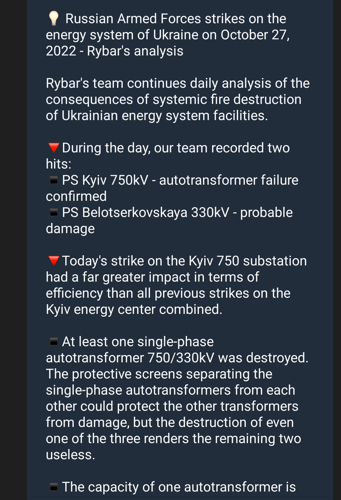
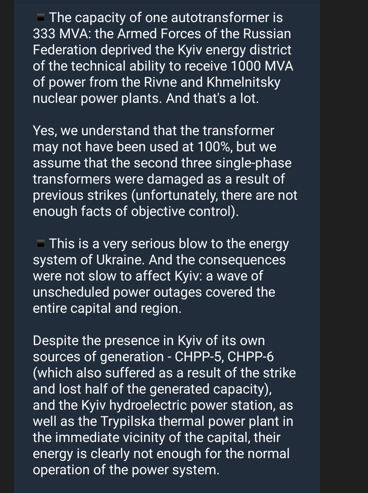
Source: https://t.me/s/rybar
For Rybar’s commentary on US training of Ukrainian forces in Romania combined with attacks on the electricity grid between the Odessa region and Moldovan power plants, read this. For USAF targeting for the Sevastopol drone attacks of October 28-29, click. For Italian radar tracking confirmation of the operation of the Sigonella, Sicily, airbase to provide the drone guidance support, read.
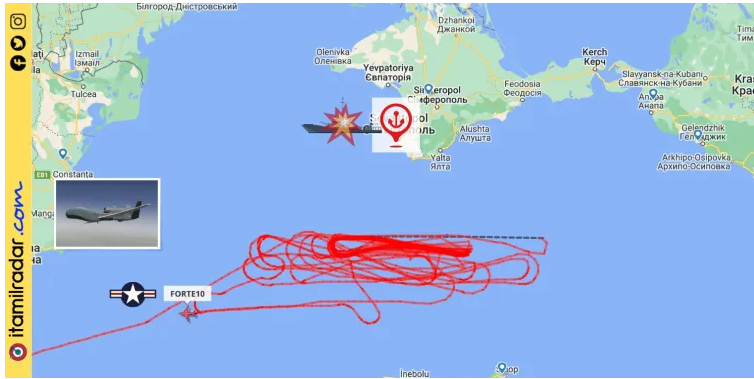
“Tonight a Ukrainian attack hit the Russian naval base in Sevastopol hard. It is not yet clear what damage was done to the Russian fleet, but it seems that the frigate ‘Admiral Makarov’, the current flagship of the Russian fleet in the Black Sea, was hit (what damage it suffered is not yet clear). During the attack (apparently carried out by marine drones) a USAF Northrop Grumman RQ-4B (reg. 11-2046 – callsign FORTE10) was conducting a surveillance mission in the area south of Sevastopol. The aircraft arrived over the Black Sea at 08:30 CEST on 28 October and left at around 08:45 CEST on 29 October. This type of mission is usual for USAF drones based at Sigonella.” Source: https://www.itamilradar.com//
Asked to say if the loss of capacity is now 30% or greater, DTEK chief executive Timchenko said: “I certainly don’t want to challenge the minister’s statement. [I]t can be perceived in different ways. ‘Out of operation’ in terms of the fact that we have lost connection systems – [that] is correct. That is, if we do not have connections with generating stations, as I said, then we have lost 30% of the capacity when it comes to the process of energy delivery to the consumer. Why were the rolling blackouts implemented? Because the power that was produced could not be delivered to the grids.”
An American grid maintenance specialist notes that “well-off Ukrainians who can afford the cost are tying in thousands of small generators but this creates fresh hazards to both utility crews conducting repairs and the electrical gear they are working on. The biggest danger will be due to improper installation of generators in residential or small commercial settings. Such improvised tie-ins — in many cases completed by unqualified personnel without inspection — will lead to dangerous voltages and currents being backfed onto utility lines.”
Timchenko of DTEK acknowledged that the Russian strategy is to leave the Ukrainian power plants capable of generating the electricity, but to cut off the lines connecting them to the grid, the military supply links in the west and south, and the front regions where the Ukrainian Army claims to be recapturing ground and preparing new offensives. “There is enough own capacity within Ukraine to get through the winter and for normal operation. The problem is the hits and damage done to the infrastructure that allows this power to be provided… I believe that we cannot have some kind of Armageddon, a situation where everything will be broken, and we will end up having a total blackout. I don’t believe [we will have] this scenario. Although I did not believe in a war with Russia. Everything is possible, but based on how we have performed and how the system has performed in terms of sustainability, I have confidence that we will cope with these challenges.”
“Again, in conjunction with the military. I rely heavily on Ukrainian Air Defense Forces. Still, even with such a massive attack, more than 50% of the missiles have been shot down. These are certain lessons for us and for the military, how to deal with such situations.”
A Canadian military source is skeptical of Ukrainian announcements of high rates of interception of Russian missiles and drones, and their republication in the London, Washington, and Berlin press. “Do you remember the quip from German soldiers near the end of World War Two? I believe it went something like this: ‘If you see a lot of planes, that’s the Americans. If you see fewer planes, that’s the British. If you don’t see any planes, that’s the Luftwaffe.’ This is my impression of Ukrainian air defence.”
The Canadian source also dismissed experts being promoted in US media. “The video evidence shows police and militiamen firing wildly in the air with personal weapons at the sight of the incoming drones. That’s morale boosting. It isn’t air defence.”
An expert source in the US adds: “The Russians know that US-NATO is throwing what it can in terms of air defence weaponry at the Ukraine. They also know that re-supply is an issue right across the west, including the US defence industry, because stocks are running down and delivery just in time is proving far too late. So, I suspect the Russians are throwing cheap, easy to manufacture drones at Ukrainian targets, many of which are shot down, while more than enough get through. But the secondary mission is to exhaust limited stocks of US- NATO anti-aircraft missiles. After some days of this, the Russians switch back to using their more expensive and accurate cruise and ballistic missiles, as well as drones, at infrastructure targets and against depleted Ukrainian AD.”
The “secondary” mission becomes the strategic Russian objective when the Pentagon and the Joint Chiefs of Staff are being compelled to decide whether to rush more advanced missile interception systems to the battlefields in the west and south; and also whether to risk American operators inside the Ukraine because Ukrainians cannot be trained fast enough.
According to a Reuters report from the Pentagon on October 11, “the United States has approved sending Ukraine a total of eight National Advanced Surface-to-Air Missile Systems (NASAMS) so far, with two expected to be delivered soon and six more sent over a longer time frame. ‘We think that we’re on track to get those first two over there in the very near future,’ [Pentagon spokesman Admiral John] Kirby said during a briefing for reporters. ‘We are certainly interested in expediting the delivery of NASAMS to Ukraine as soon as we can.’”
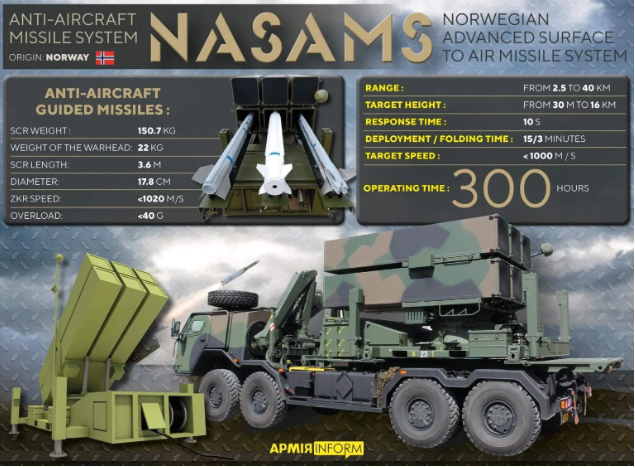
NASAMS=Norwegian or National Advanced Surface to Air Missile Systems. The initial Ukrainian announcement of NASAMS deployment and training does not say which model is being supplied: https://news.yahoo.com/ and https://en.wikipedia.org/
The Raytheon announcement of October 25 also omitted to identify the model; it did qualify the number and acknowledged the delay in delivery.
The North American source comments: “How will it look when the NASAMS don’t work, just as other US air defence schemes have time and again in the past. How to explain $20,000 drones beating multi-billion dollar systems? The problem for [Joint Chiefs Chairman General Mark] Milley is acute — how to deliver and operate NASAMS without the Russian side capturing it?”
Russian sources believe the Stavka strategy is not (repeat not) aimed at Ukrainian morale. They know this is holding up, just as the US and British airforces discovered was true of the Germans and Japanese during (and despite) the Allied strategic bombing campaigns of World War II.
Public opinion polling by the Kiev International Institute of Sociology, measured by telephone calling between October 21 and 23, confirms this, albeit with significantly greater enthusiasm for the war from the Galicians and those in Kiev who are benefitting from the foreign cashflows:
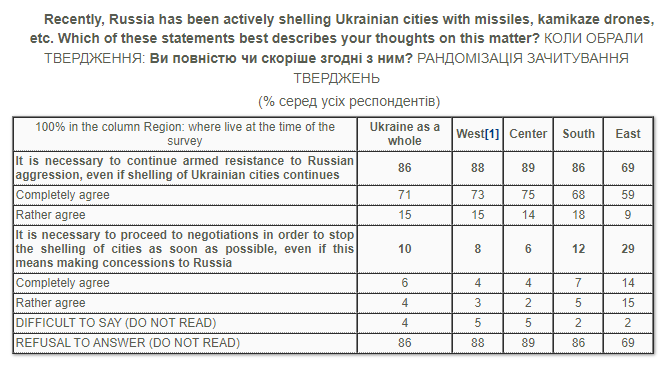
Source: https://www.kiis.com.ua/
“In our opinion, a more significant impact on representativeness can be either a generally lower willingness of citizens with ‘pro-Russian’ attitudes to participate in surveys, or the insincerity of those who did take part in the survey (taking into account the obvious facts and prevailing opinions in the media regarding the Russian invasion , some citizens will not want to say what they really think ‘in public’). If to talk about the general willingness of respondents to participate in the survey, then in recent surveys we see either the same indicators or somewhat lower (although it should be borne in mind that the lower willingness to participate of ‘pro-Russian’ citizens can be compensated by the higher willingness to participate of ‘pro-Ukrainian’-minded citizens).”
As this Kiev qualifier concedes, walking may be a better measure of Ukrainian sentiment than talking. But Russian sources interpret the Stavka strategy as aimed at the politically weak governments in Warsaw, Berlin, Paris and London; they are already facing swelling domestic protests at spending more and more money on the Ukrainians, while budget cuts are being imposed on domestic welfare and consumption, including what the French are calling pénurie de carburant.
“If Ukrainian refugee flows accelerate – and they will when this October’s unusually warm temperatures come to an end – then the political choices for war or peace will sharpen,” a Moscow source says.
For the time being, the Polish Border Guard arrival and exit data, issued each day, show relatively stable and equal flows of Ukrainians into Poland and of those returning home. However, the daily figures also reveal that following the October 10 raids against the electric grid there was a small increase in cross-border movement into Poland, accompanied by a larger drop in the number of Ukrainians who had previously been crossing to return home and have opted to stay in Poland.

Source: https://twitter.com/
Counting October 1 through 29, a total of 695,700 Ukrainians crossed the border into Poland; this is an average of 23,990 per day. However, on the days from October 11 through 16, the daily inflow jumped to between 25,000 and 26,000. This is an increase of 5.5%.
Counting the repatriation movements, a total of 677,200 Ukrainians crossed from Poland into the Ukraine for an average of 23,352 per day. Between October 11 and 16, this outflow dropped to 17,300 on the first day, and averaged 18,033 over the six days. That was a decline of 22.8%.
Sources in Warsaw say they are expecting the inflow to accelerate with the onset of winter, and the outflow to shrink. Combined with the Russian campaign against the electric grid, the effect may be another overwhelming refugee problem inside Poland, and also westwards into Germany, Czech Republic, Austria, and Hungary.
MAP OF UKRAINIAN POPULATION MOVEMENTS SINCE FEBRUARY 24, 2022
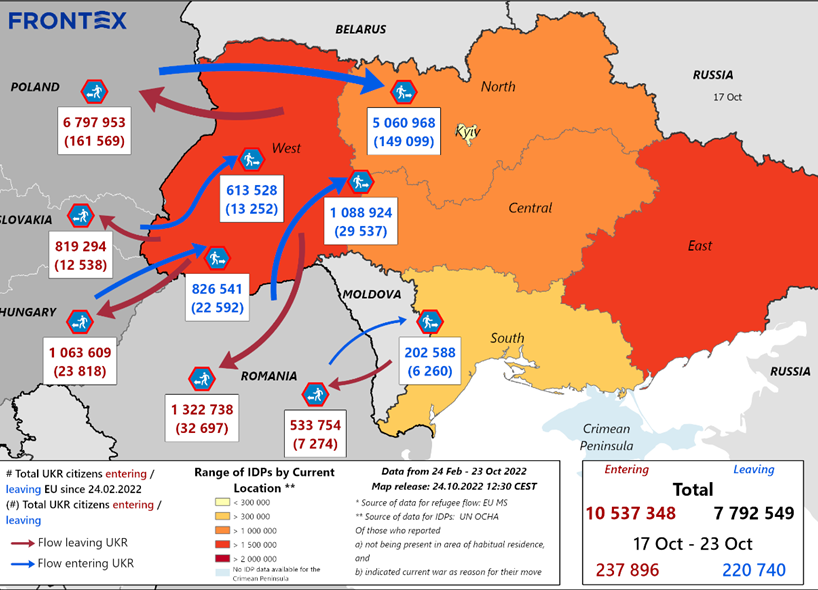
Source: https://frontex.europa.eu/
Reading the daily Rybar report on the Russian operations, and the daily tweet from the Polish Board Guard, and it will become clear why the passenger trains, bus and car routes out of Galicia and into Poland will continue to remain open.
[*] A Brookings report, issued in October this year, reveals that the Biden White House staff turnover in the first two years of the administration has been more rapid than any predecessor in the past forty years – and this isn’t counting yet departures likely after the November 8 elections.
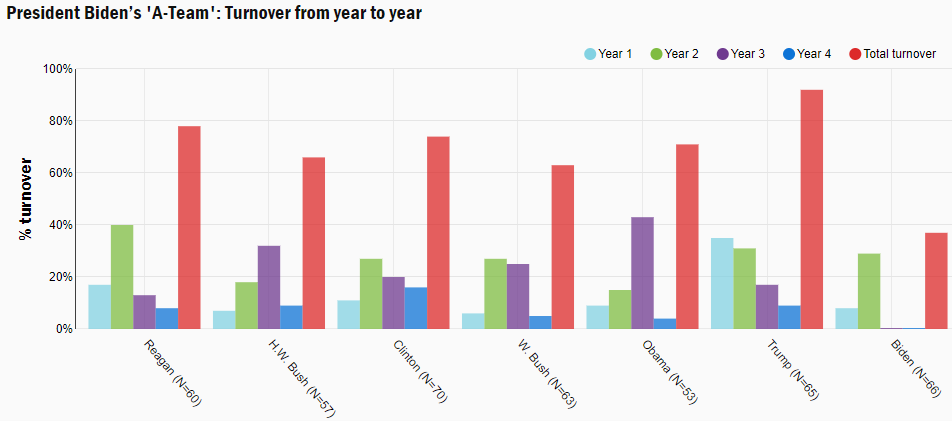


Noting the big population movements westward, as described and as portrayed in the map. A little problem for media workers emerges. I see so many gleeful articles in U.S. publications about difficulty in the Russian mobilization.
Left unsaid, natch, is where the Ukrainians have gone to. Helmer’s figures make the missing mobilization of Ukrainians quite clear.
From this Atlantic article–2020
Wikipedia’s estimate as of today is 41.1 million.
Who puts a country of 41 million people up against the Russian Federation?
War is a racket. War is always absurd. Yet this proxy war smacks of being remarkably stupid, enflamed by the self-stupefied Anglo-American elites.
The Atlantic article that I refer to about Ukrainian demographic collapse:
https://www.theatlantic.com/international/archive/2020/03/ukraine-eastern-europe-depopulation-immigration-crisis/608464/
The quote from the WaPo sums everything up. The power players in DC are surprised that Russia is using technical knowledge of energy systems (and the Ukrainian energy system in particular) to execute precise and methodical strikes. We’re back to DC assuming that Russia would do things the way the US would do them and that’s been costly to the US in this conflict.
I don’t think the strikes will significantly affect publicly reported morale of Ukrainians, but on Ukrainian channels there’s more and more talk about the interception lies. Today Kiev said 44 of 50 missile/drones shot down, but since people are ignoring the order not to film strikes it’s becoming a joke that 6 missiles hit 18 infrastructure objects in 10 regions. Because official government channels also reported the 18 strikes in 10 regions. It’s not going to change the overall opinion, but Kiev’s response is undermining its legitimacy in some ways.
The joke is that Ukraine intercepts drones and missiles with its electrical infrastructure. When one looks at it this way then Ukraine’s reported AD successes are, if anything, underplaying its rate of success.
Yeah, Russia ran out of missiles months ago remember? So it must be the Ukies hitting their own infrastructure with HIMARS, Howitzers and whatever else the West has sent them.
‘Again recall that the transmission lines in Ukraine are Soviet-built to old Soviet standards (750/330kV) and have been updated with Russian equipment. No one in the West can replace the transformers and other critical elements Russia is destroying.’
Looks like that that is going to have to be one of the clauses of the eventual peace negotiations. That the Russian Federation will agree to sell transformers and other electrical gear to the Ukraine as they may be the only country where electrical gear is still manufactured to that spec. Of course the Collective West could step in and heroically announce that they will totally replace all the old Soviet electrical gear in the Ukraine with EU-standard electrical gear. I would be wary of that offer though. The collective West went in and destroyed the Iraq electrical grid and said that they would rebuild it and spent billions doing so. After twenty years, the Iraq electrical grid is still wonky and performs worse whereas under Saddam Hussein at least it was reliable.
Comrade Rev Kev, you are underreporting how successful the reconstruction effort was in terms of lining up the pockets of certain companies. That’s the only metric that counts, so the reconstruction of Iraq’s electrical grid was an utterly successful endeavor.
Let’s let the former head of the Coalition Provisional Authority in Iraq, Paul Bremer, tell us how successful the reconstruction effort was…
https://www.cbsnews.com/news/paul-bremer-who-helped-run-iraq-occupation-is-now-a-ski-instructor/
These people never have any genuine awareness of, let alone regrets about, the death and suffering they caused. They’re really on a par with the 1948 Nuremberg defendants in that respect.
Largest transformer factory in Europe is/was the ZTR factory located in Zaporozhe.
Would be interesting to know if it is still standing.
It would be hilarious if the Russians eventually had to tell the Ukrainians that it will take a very long time to supply that gear because, wouldn’t you know it, somebody shelled that plant with artillery and wrecked the whole plant.
Just in passing, when there was that attack on Sevastopol the other day, at the same time the Ukrainians tried yet again to land at Energodar to seize the Zaporozhe nuke plant by commandos in speedboats. The Russians shot them up and about 60 were killed. A brief 11 second video has emerged showing this attack.
Oops. Forgot to link that clip-
https://www.bitchute.com/video/zebukarT6j1r/ (11 secs)
Is that one of the power plants, of all kinds – nuclear, hydroelectric, etc, that the World Bank expects to be privatised in return for loans?
Why, yes! I do believe it is.
I may be totally wrong, but I think even Russia is getting (some/most of) it’s transformers for the Soviet system from Kazakhstan. You know, Soviet Union being equal opportunity industrializer and all that.
It also helps that the *stans are using the same system and sharing their Soviet era grid with Russia, of course.
It seems the Americans never considered that the Russians would call a retired Soviet engineer to explain the Uk. electrical grid’s system. Reminds me of Bernie saying “I wrote the damn bill”. Pass the hubris and hold the onions.
IIRC the largest transformer manufacturer in Europe is in Zaporozhye city but they closed due to supply chain problems earlier this year.
Re the different rail gauges–I’ve read that this was a deliberate choice by Russia to discourage foreign attack and it was a factor both in WW1–when armies moved by rail–and in WW2 when the German invasion had to depend on bad Russian roads.
And for more on the military situation there’s a new Big Serge.
https://bigserge.substack.com/p/sound-and-fury
Russian military realized even before any track was build that disrupting train traffic had very little to do with gauge, and a lot to do with destroying bridges.
The “Russian standard gauge” was chosen because they had already build one standard gauge (4 feet 8½ inch) track and one wide gauge (6 feet) track, and it seemed 5 feet was cheaper to build than wider track and cheaper to maintain than narrower track. And when you plan to build a lot of track, it soon adds up.
I assume the Russians would also have chosen broad gauge because it allows higher load capacities on poorer ground and you never know what you find east of the Urals.
Re the different rail gauges–I’ve read that this was a deliberate choice by Russia to discourage foreign attack
This has been argued for decades in railway buffs publications and fora. Essentially nobody knows. The very first railway in Russia (St. Petersburg to Tsarskoye Selo in the late 1830’s) was standard 4 foot 8 and a half inches but after an Imperial commission returned from the UK (in the 1850’s I think) the 5 foot gauge was adopted. It could be anything from a measurement error or typo in a record to a desire for a slightly different gauge —Ireland went with 5 foot and Brunell championed a 7 foot gauge— to discouraging foreign attack.
Small drones can be made radar bright, the opposite of stealthy. It requires light weigt flat panels facing radar transmitters.
They do not need a warhead, as their purpose is to distract, a little like propaganda pushed by the anti-Ye media.
Being smaller than observed under radar, sophisticated missiles have a higher chance of missing them and are a waste even if they do disable. They can also be used to drop chaff and flares, in modest amounts.
There will be a storm soon, of many drones. Once the missiles are sent up, and the few reloads, what will be the defences agains other drones, missiles and aircraft?
If USAF planes are co-ordinating attacks, are they legitimate targets under the hot pursuit doctirne? Or are these pinpricks to be allowed to continue damaging the USA and NATO.
‘Never interfere with an enemy while he’s in the process of destroying himself. ‘ The point being that there are wider dimensions to this Joke.
How much lead is there, in the water supply to the Pentagram?
As I’ve commented in the past, the Russians have settled in for a prolonged conflict- note I didn’t say war, I said conflict.
This “attack-measure the results-attack again cycle” is not aimed at maximizing disruption. It is aimed at a calibrated reduction in electrical supply. There have been no attacks on the very vulnerable district heating systems.
Russia has turned the Ukrainian thermostat down to 55, uncomfortable but not the end of the world, and said “Have a nice winter”.
12.77 degrees Celsius to be precise :-) Ukraine (and Russia) both using Celsius unit of measurement, for temperature :-)
This is important reporting. Logistics and supply win wars of attrition, as learned by the Wehrmacht at Stalingrad and the IGN at Rabaul. Rifles need cartridges, tanks need fuel, troops need food — and bandages.
Important to reemphasize two of Helmer’s side points: 1) Russian strategy appears to be aimed at carving-off the Europeans from the Americans; 2) There is a very real danger of NATO or U.S. troops being “invited” to occupy currently uncontested “Ukrainian” territory, in particular Odessa. Both destabilizing and create the potential for escalating the conflict beyond the current civil war in Novorussia.
Remind me again: Why can’t “Ukraine” be a neutral multicultural federation like Switzerland? What is the social utility of an oligarch or a billionaire?
What are the chances that the Russians will create an atmosphere where Polish nationalists start demanding a “Right of Return” for ethnic Poles in Galicia?
It seems to me that Polish expansion of control in the Western Ukraine, we are talking defacto control of the security apparatus there, not a full annexation, would serve Russian goals.
The standard Russian end user voltage-hertz is 240-50hz. Just like the rest of Europe.
But how get your source voltage to the end user can vary a lot. So it is very possible that knocking out intermediate switching stations/transformers can take longer than typical to replace.
There are two problems more serious than the magically different old soviet system.
One is that utility transformers are way backed up in orders everywhere. The lead time is on transformers is 18 months vice the usual 3 months. It isn’t that hard to tap a transformer differently if you have all the components on hand. But obviously, that isn’t the case.
The second issue is that these are very expensive items, and that there are limited numbers of people that can install them. In the United States, every time you get a hurricane, huge numbers of teams from other areas come in to assist. If too many disasters happen at one time, you have real problems. In the case of the Ukraine, it is highly unlikely that whatever resources they might to repair their grid are not already mostly absorbed in fixing previous damage or otherwise absorbed into the military.
So the repairs, other than absolutely essential areas using canabalized equipment from less essential needs), is going to have to wait for peacetime and bunch of money to fund European crews.
The longer-long distance lines are 330kV. That has been reported widely. And Europe does not have the equipment to replace that.
One wonders where and who are the current suppliers of Grid (large) Transformers? Chinese Companies?
Probably Russian ones for 330KV. I believe that the system was exclusively used by FUSSR.
Used to be a company in Zaporizhzhia (largest in Europe) but they shut down earlier this year due to supply chain problems.
song to the nights the lights went off in georgia(the ukraine that is!)
the average nafta type that came to power in 1993 is most likely asking why can’t we just go out and buy the electrical equipment that is needed, after all, we have the money, SARC!
It seems likely there will be renewed migration out of Ukraine as winter arrives even if heat can still be provided. No electric, no refrigeration, no light, no devices, little fuel for cars… who will stay?
I wonder what the cost is to Russia in terms of lost soldiers in using a protracted war strategy.
It’s impossible to get accurate figures from any side Aa the West will exaggerate and the Russians probably want to provide minimal information to the Russian public.
Your assumption is incorrect. Russia’s slow, grinding strategy is designed to preserve their troops. “Protracted” saves Russian lives.
And by happenstance, the Ukraine insistence on holding terrain at all costs, as opposed to making tactical retreats, is extremely costly in terms of deaths and injuries.